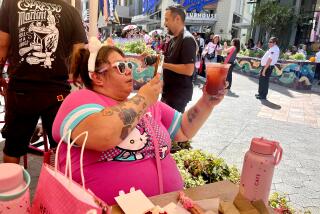Coffeehouse Owners in Little Saigon Told They Must Lighten Up : Regulation: Police complain that the popular--but dark--meeting places attract gang members, so the city imposes new rules.
WESTMINSTER — Even on the brightest summer days, Little Saigon’s coffeehouses are cool and dark, a haven from the blistering heat of the pavement outside.
With their tinted windows, dim lighting and overhead fans, the cafes are a cultural institution, a place where Vietnamese expatriates gather to chat as they sip iced coffee, smoke cigarettes and watch the numbers on colorful Keno game monitors.
In recent months, however, Westminster police and city officials have become increasingly concerned that some coffeehouses have become meeting places for gang members.
Officers who patrol the area say that those invitingly dim interiors make it difficult to see through the haze to investigate reports of trouble.
“We need to be able to see inside without using our flashlights during the day,” said Police Detective Tom Rackleff. The dim lighting and lingering smoke, he said, “put us at a great disadvantage.”
To help solve the problem, the Westminster City Council has approved an ordinance that sets a minimum level for indoor lighting, limits how dark windows can be tinted, restricts the number of video games to four and require that cafes close at midnight.
Owners must now get special permits for karaoke, which draws a young crowd to sing along on stage to music tracks. Patrons under 18 must leave the cafes by 10 p.m. The city also has outlawed smoking at coffeehouses, at least a year before a similar state ban goes into effect, officials said.
Critics say that the regulations designed to solve problems at a few coffeehouses would unfairly hurt all of them.
“It’s going to be tougher to do business,” said Denny Tran, manager of Little Saigon’s Ca Phe Luc Huyen Cam. “Especially the [regulations on] karaoke. It’s very popular in this community.”
The subject received little discussion last week when the City Council unanimously approved the ordinance, although the regulation of coffeehouses has been debated in the community for more than a year.
In April, 1994, three shootings at Little Saigon cafes in less than a week left two people dead and several others wounded. The gunfire suddenly focused attention on the coffeehouses, which have bloomed in Westminster and Garden Grove since the mid-1970s and, since they do not serve alcohol, usually are licensed in the same manner as restaurants.
After the shootings, members of the city’s Planning Commission and other officials spent several evenings visiting coffeehouses, sometimes with police escorts, and speaking to patrons. Some were frequented by groups of youths, they said.
“Young gang members get together and decide what they want to do and what hell they’re going to raise that night,” said Arthur Gandy, a Planning Commission member who helped draft the ordinance.
*
Last week, while in the Little Saigon area, Police Sgt. Rick McKinney received a radio call that several teen-agers had been seen leaving a shopping center in a stolen van.
Officers tracked five young male passengers, who had jumped out of the van, to a nearby coffeehouse. Police at the scene identified the youths as gang associates from outside Westminster.
“This is very typical,” McKinney said, as he stood in a parking lot near where the youths were being questioned. “These guys came here to try and get a ride home from some other gang member. And notice which one they come to-- with the low lighting and dim windows.”
Gesturing to a bright, airy restaurant next door, McKinney noted, “they don’t go to that one.”
Gandy, the Planning Commission member, said that when officials were visiting coffeehouses, they would often notice “guys running out the door, down the street to the next [cafe] to tell them we were coming. They didn’t even depend on the telephone, just ran down the street.”
Co Pham, president of the Vietnamese Chamber of Commerce, said he agreed with some parts of the ordinance, but criticized other aspects. “The lights should be brighter,” Pham said, but the curfews could “jeopardize a lot of businesses.
“A lot of [coffeehouse patrons] work night shifts and have little social life,” Pham said. “They like to come for coffee or tea or soda after work. It’s a healthy activity.”
Pham moved his medical offices out of a Bolsa Avenue strip mall last year after violence erupted at a coffeehouse next door. But he did not think the regulations would help control gang activity.
“Instead of trying to solve the problem from the root, they are trying to solve the problem from the top,” he said. “Police have to be working harder to solve crime instead of just saying to close the coffeehouses.”
Gandy, however, disagreed. “We’re trying to protect people, and the coffeehouse owners, by putting these things in place. We’re trying to look ahead and not just react when [violence] happens.”
More to Read
Sign up for Essential California
The most important California stories and recommendations in your inbox every morning.
You may occasionally receive promotional content from the Los Angeles Times.










